Spatiotemporal Prescribed Fire Patterns in Washington State, USA
Abstract
:1. Introduction
- How does prescribed fire area burned covary with wildfire area burned?
- How do prescribed fire activities covary with land ownership or vegetation?
- How do prescribed fire activities vary with time?
- How do prescribed fires that are approved by the DNR differ from those that are denied?
2. Methods
2.1. Data
2.2. Statistical Analyses
2.2.1. Wildfire and Prescribed Fire
2.2.2. Spatial Variation
2.2.3. Temporal Variation
2.2.4. Variation between Approved and Denied Requests
3. Results
3.1. Wildfire and Prescribed Fire
3.2. Spatial Variation
3.2.1. Land Ownership
3.2.2. Ecoregions
3.3. Temporal Variation
3.3.1. Interannual
3.3.2. Seasonal
3.4. Variation between Approved and Denied Fires
4. Discussion
4.1. Wildfire and Prescribed Fire
4.2. Spatial Variation
4.2.1. Land Ownership
4.2.2. Ecoregions
4.3. Temporal Variation
4.3.1. Interannual
4.3.2. Seasonal
4.4. Variability in Burn Characteristics Across Approval Outcomes
4.5. Caveats and Future Work
5. Conclusions
Supplementary Materials
Author Contributions
Funding
Data Availability Statement
Acknowledgments
Conflicts of Interest
References
- Trauernicht, C.; Brook, B.W.; Murphy, B.P.; Williamson, G.J.; Bowman, D.M. Local and global pyrogeographic evidence that indigenous fire management creates pyrodiversity. Ecol. Evol. 2015, 5, 1908–1918. [Google Scholar] [CrossRef] [Green Version]
- Boyd, R. Indians, Fire and the Land, 1st ed.; Oregon State University Press: Corvallis, OR, USA, 1999; pp. 4–15. [Google Scholar]
- Ryan, K.C.; Knapp, E.E.; Varner, J.M. Prescribed fire in North American forests and woodlands: History, current practice, and challenges. Front. Ecol. Environ. 2013, 11, e15–e24. [Google Scholar] [CrossRef]
- Vermeire, L.T.; Mitchell, R.B.; Fuhlendorf, S.D.; Wester, D.B. Selective control of rangeland grasshoppers with prescribed fire. Rangel. Ecol. Manag. 2004, 57, 29–33. [Google Scholar] [CrossRef]
- Fornwalt, P.J.; Rhoades, C.C. Rehabilitating slash pile burn scars in upper montane forests of the Colorado Front Range. Nat. Areas J. 2011, 31, 177–182. [Google Scholar] [CrossRef]
- Fernandes, P.M.; Botelho, H.S. A review of prescribed burning effectiveness in fire hazard reduction. Int. J. Wildland Fire 2003, 12, 117–128. [Google Scholar] [CrossRef] [Green Version]
- Kolden, C.A. We’re not doing enough prescribed fire in the Western United States to mitigate wildfire risk. Fire 2019, 2, 30. [Google Scholar] [CrossRef] [Green Version]
- Engebretson, J.M.; Hall, T.E.; Blades, J.J.; Olsen, C.S.; Toman, E.; Frederick, S.S. Characterizing public tolerance of smoke from wildland fires in communities across the United States. J. For. 2016, 114, 601–609. [Google Scholar] [CrossRef]
- Navarro, K.M.; Schweizer, D.; Balmes, J.R.; Cisneros, R. A review of community smoke exposure from wildfire compared to prescribed fire in the United States. Atmosphere 2018, 9, 185. [Google Scholar] [CrossRef] [Green Version]
- Williamson, G.J.; Bowman, D.M.S.; Price, O.F.; Henderson, S.B.; Johnston, F.H. A transdisciplinary approach to understanding the health effects of wildfire and prescribed fire smoke regimes. Environ. Res. Lett. 2016, 11, 125009. [Google Scholar] [CrossRef]
- Packham, D.R.; Vines, R.G. Properties of bushfire smoke: The reduction in visibility resulting from prescribed fires in forests. J. Air Pollut. Control Assoc. 1978, 28, 790–795. [Google Scholar] [CrossRef]
- Abdel-Aty, M.; Ekram, A.; Huang, H.; Choi, K. A study on visibility obstruction related crashes due to fog and smoke. Accid. Anal. Prev. 2011, 43, 1730–1737. [Google Scholar] [CrossRef]
- Watts, A.C.; Kobziar, L.N. Smoldering combustion and ground fires: Ecological effects and multi-scale significance. Fire Ecol. 2013, 9, 124–132. [Google Scholar] [CrossRef]
- Cisneros, R.; Schweizer, D.W. The efficacy of news releases, news reports, and public nuisance complaints for determining smoke impacts to air quality from wildland fire. Air Qual. Atmos. Health 2018, 11, 423–429. [Google Scholar] [CrossRef]
- Urbanski, S. Wildland fire emissions, carbon, and climate: Emission factors. For. Ecol. Manag. 2014, 317, 51–60. [Google Scholar] [CrossRef]
- Ottmar, R.D.; Peterson, J.L.; Leenhouts, B.; Core, J.E. Smoke Management: Techniques to Reduce or Redistribute Emissions. In Smoke Management Guide for Prescribed and Wildland Fire, 2001 ed.; National Wildfire Coordination Group: Boise, ID, USA, 2001; pp. 141–160. [Google Scholar]
- Parker, T.J.; Clancy, K.M.; Mathiasen, R.L. Interactions among fire, insects and pathogens in coniferous forests of the interior western United States and Canada. Agric. For. Entomol. 2006, 8, 167–189. [Google Scholar] [CrossRef]
- Hartsough, B.R.; Abrams, S.; Barbour, R.J.; Drews, E.S.; McIver, J.D.; Moghaddas, J.J.; Schwilk, D.W.; Stephens, S.L. The economics of alternative fuel reduction treatments in western United States dry forests: Financial and policy implications from the National Fire and Fire Surrogate Study. For. Policy Econ. 2008, 10, 344–354. [Google Scholar] [CrossRef]
- State of Washington Department of Natural Resources Smoke Management Plan. Available online: https://www.dnr.wa.gov/publications/rp_burn_smptoc.pdf (accessed on 19 January 2021).
- Chiodi, A.M.; Larkin, N.S.; Varner, J.M. An analysis of Southeastern US prescribed burn weather windows: Seasonal variability and El Niño associations. Int. J. Wildland Fire 2018, 27, 176–189. [Google Scholar] [CrossRef]
- Melvin, M.A. 2018 National Prescribed Fire Use Survey Report; Coalition of Prescribed Fire Councils, Inc.: Newton, GA, USA, 2018; p. 22. Available online: http://www.prescribedfire.net/resources-links (accessed on 19 January 2021).
- Peterson, J.L. Regulations for Smoke Management. In Smoke Management Guide for Prescribed and Wildland Fire, 2001 ed.; National Wildfire Coordination Group: Boise, ID, USA, 2001; pp. 61–74. [Google Scholar]
- Core, J.E. State Smoke Management Programs. In Smoke Management Guide for Prescribed and Wildland Fire, 2001 ed.; National Wildfire Coordination Group: Boise, ID, USA, 2001; pp. 75–80. [Google Scholar]
- Schultz, C.A.; McCaffrey, S.M.; Huber-Stearns, H.R. Policy barriers and opportunities for prescribed fire application in the western United States. Int. J. Wildland Fire 2019, 28, 874–884. [Google Scholar] [CrossRef]
- Nowell, H.K.; Holmes, C.D.; Robertson, K.; Teske, C.; Hiers, J.K. A new picture of fire extent, variability, and drought interaction in prescribed fire landscapes: Insights from Florida government records. Geophys. Res. Lett. 2018, 45, 7874–7884. [Google Scholar] [CrossRef] [Green Version]
- Provost, F.; Domingos, P. Tree induction for probability-based ranking. Mach. Learn. 2003, 52, 199–215. [Google Scholar] [CrossRef]
- Sakia, R.M. The Box-Cox transformation technique: A review. J. R. Stat. Soc. 1992, 41, 169–178. [Google Scholar] [CrossRef]
- McLeod, A.I. Kendall: Kendall Rank Correlation and Mann-Kendall Trend Test. R Package Version 2.2. 2011. Available online: https://CRAN.R-project.org/package=Kendall (accessed on 7 April 2021).
- R Core Core Team. R: A Language and Environment for Statistical Computing. 2019. Available online: http://www.R-project.org (accessed on 14 December 2018).
- Podschwit, H.; Cullen, A. Patterns and trends in simultaneous wildfire activity in the United States from 1984 to 2015. Int. J. Wildland Fire 2020, 29, 1057–1071. [Google Scholar] [CrossRef]
- Goodman, S.N. Of P-values and Bayes: A modest proposal. Epidemiology 2001, 12, 295–297. [Google Scholar] [CrossRef] [PubMed]
- Halsey, L.G. The reign of the P-value is over: What alternative analyses could we employ to fill the power vacuum? Biol. Lett. 2019, 15, 20190174. [Google Scholar] [CrossRef] [Green Version]
- Kass, R.E.; Raftery, A.E. Bayes factors. J. Am. Assoc. 1995, 90, 773–795. [Google Scholar] [CrossRef]
- Hope, A.C.A. A simplified Monte Carlo significance test procedure. J. R. Stat. Soc. Ser. B 1968, 30, 582–598. [Google Scholar] [CrossRef]
- Gantt, B.; Beaver, M.; Timin, B.; Lorang, P. Recommended metric for tracking visibility progress in the Regional Haze Rule. J. Air Waste Manag. Assoc. 2018, 68, 438–445. [Google Scholar] [CrossRef] [PubMed] [Green Version]
- Prather, J.W.; Noss, R.F.; Sisk, T.D. Real versus perceived conflicts between restoration of ponderosa pine forests and conservation of the Mexican spotted owl. For. Policy Econ. 2008, 10, 140–150. [Google Scholar] [CrossRef]
- Quinn-Davidson, L.N.; Varner, J.M. Impediments to prescribed fire across agency, landscape and manager: An example from northern California. Int. J. Wildland Fire 2012, 21, 210–218. [Google Scholar] [CrossRef]
- Cansler, C.A.; McKenzie, D. Climate, fire size, and biophysical setting control fire severity and spatial pattern in the northern Cascade Range, USA. Ecol. Appl. 2014, 24, 1037–1056. [Google Scholar] [CrossRef] [PubMed]
- Simmons, E.A.; Morgan, T.A.; Berg, E.C.; Hayes, S.W.; Christensen, G.A. Logging Utilization in Oregon and Washington, 2011–2015, 1st ed.; U.S. Department of Agriculture, Forest Service, Pacific Northwest Research Station: Portland, OR, USA, 2016; p. 6.
- Berg, E.C.; Morgan, T.A.; Simmons, E.A.; Zarnoch, S.J.; Scudder, M.G. Predicting logging residue volumes in the Pacific Northwest. For. Sci. 2016, 62, 564–573. [Google Scholar] [CrossRef]
- Change in Burn Permit Fee. Available online: https://www.dnr.wa.gov/Publications/rp_burn_qa_permitfee_increase.pdf (accessed on 26 January 2021).
- O’Neill, S.; Peterson, J.; Callahan, J.; Rorig, M.; Curcio, G.; Johnson, T.; Larkin, S.K. The Forest Resiliency Burning Pilot Project. 2018. Available online: https://www.dnr.wa.gov/publications/rp_2018_forestry_resiliency_burning_pilot_program_report.pdf (accessed on 10 February 2021).
- McClure, C.D.; Jaffe, D.A. US particulate matter air quality improves except in wildfire-prone areas. Proc. Natl. Acad. Sci. USA 2018, 115, 7901–7906. [Google Scholar] [CrossRef] [Green Version]
- Total Population and Percent Change. Available online: https://ofm.wa.gov/washington-data-research/statewide-data/washington-trends/population-changes/total-population-and-percent-change (accessed on 15 April 2021).
- Balch, J.K.; Bradley, B.A.; Abatzoglou, J.T.; Nagy, R.C.; Fusco, E.J.; Mahood, A.L. Human-started wildfires expand the fire niche across the United States. Proc. Natl. Acad. Sci. USA 2017, 114, 2946–2951. [Google Scholar] [CrossRef] [Green Version]
- Thies, W.G.; Westlind, D.J.; Loewen, M. Season of prescribed burn in ponderosa pine forests in eastern Oregon: Impact on pine mortality. Int. J. Wildland Fire 2005, 14, 223–231. [Google Scholar] [CrossRef]
- Thies, W.G.; Westlind, D.J.; Loewen, M.; Brenner, G. Prediction of delayed mortality of fire-damaged ponderosa pine following prescribed fires in eastern Oregon, USA. Int. J. Wildland Fire 2006, 15, 19–29. [Google Scholar] [CrossRef]
- Monsanto, P.G.; Agee, J.K. Long-term post-wildfire dynamics of coarse woody debris after salvage logging and implications for soil heating in dry forests of the eastern Cascades, Washington. For. Ecol. Manag. 2008, 255, 3952–3961. [Google Scholar] [CrossRef]
- Zald, H.S.; Kerns, B.K.; Day, M.A. Limited Effects of Long-Term Repeated Season and Interval of Prescribed Burning on Understory Vegetation Compositional Trajectories and Indicator Species in Ponderosa Pine Forests of Northeastern Oregon, USA. Forests 2020, 11, 834. [Google Scholar] [CrossRef]
- Hosler, C.R. Low-level inversion frequency in the contiguous United States. Mon. Weather. Rev. 1961, 89, 319–339. [Google Scholar] [CrossRef] [Green Version]
- Houtman, R.M.; Montgomery, C.A.; Gagnon, A.R.; Calkin, D.E.; Dietterich, T.G.; McGregor, S.; Crowley, M. Allowing a wildfire to burn: Estimating the effect on future fire suppression costs. Int. J. Wildland Fire 2013, 22, 871–882. [Google Scholar] [CrossRef]
- Daniel, W.W. Statistical significance versus practical significance. Sci. Educ. 1977, 61, 423–427. [Google Scholar] [CrossRef]
- Ponisio, L.C.; Wilkin, K.; M’Gonigle, L.K.; Kulhanek, K.; Cook, L.; Thorp, R.; Griswold, T.; Kremen, C. Pyrodiversity begets plant–pollinator community diversity. Glob. Chang. Biol. 2016, 22, 1794–1808. [Google Scholar] [CrossRef] [PubMed] [Green Version]
- Senate Bill Report ESHB 2928. Available online: https://app.leg.wa.gov/committeeschedules/Home/Document/119919 (accessed on 26 January 2021).
- Dark, S.J.; Bram, D. The modifiable areal unit problem (MAUP) in physical geography. Prog. Phys. Geogr. 2007, 31, 471–479. [Google Scholar] [CrossRef] [Green Version]
- Omernik, J.M. Ecoregions of the conterminous United States. Ann. Assoc. Am. Geogr. 1987, 77, 118–125. [Google Scholar] [CrossRef]
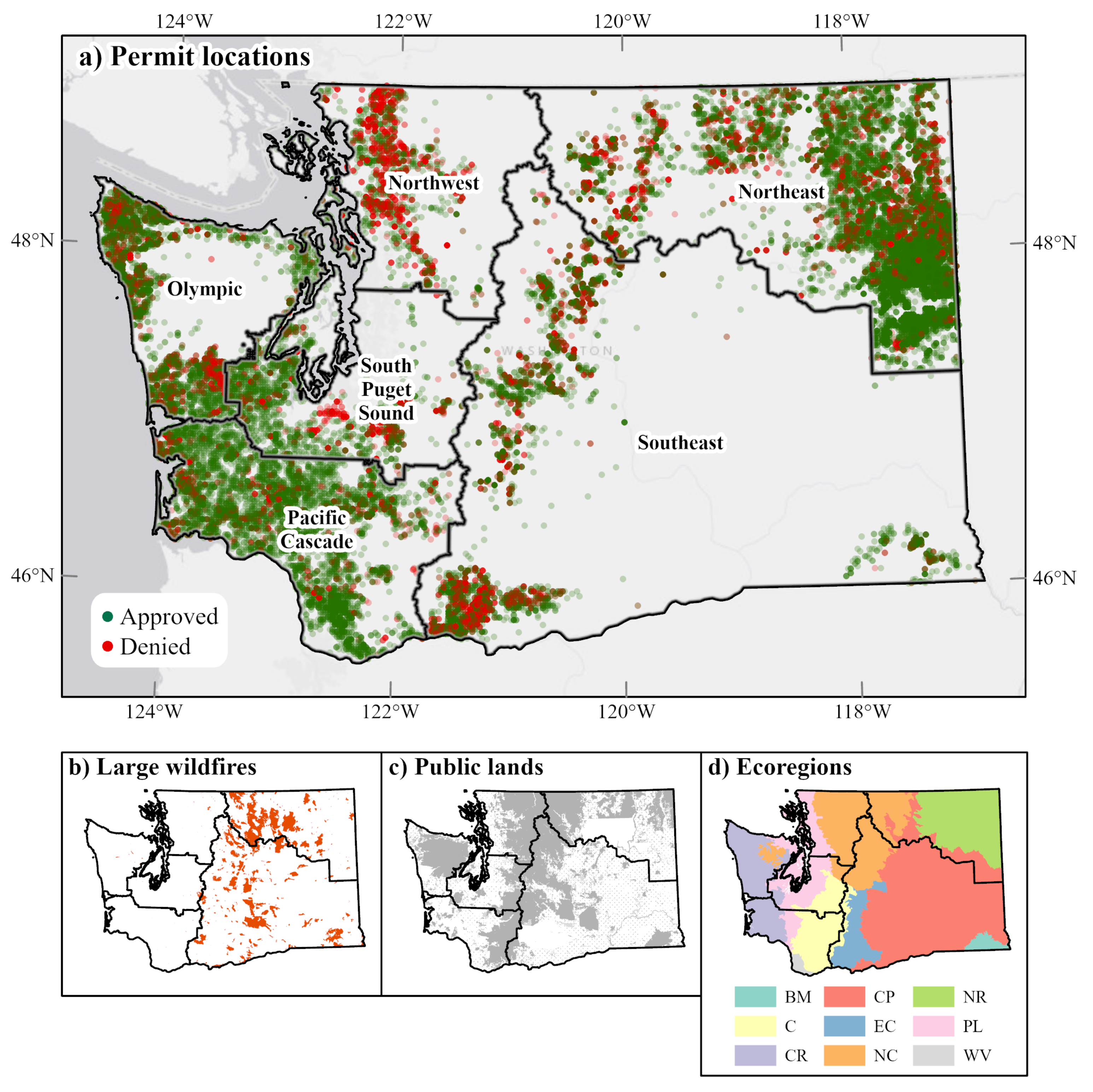
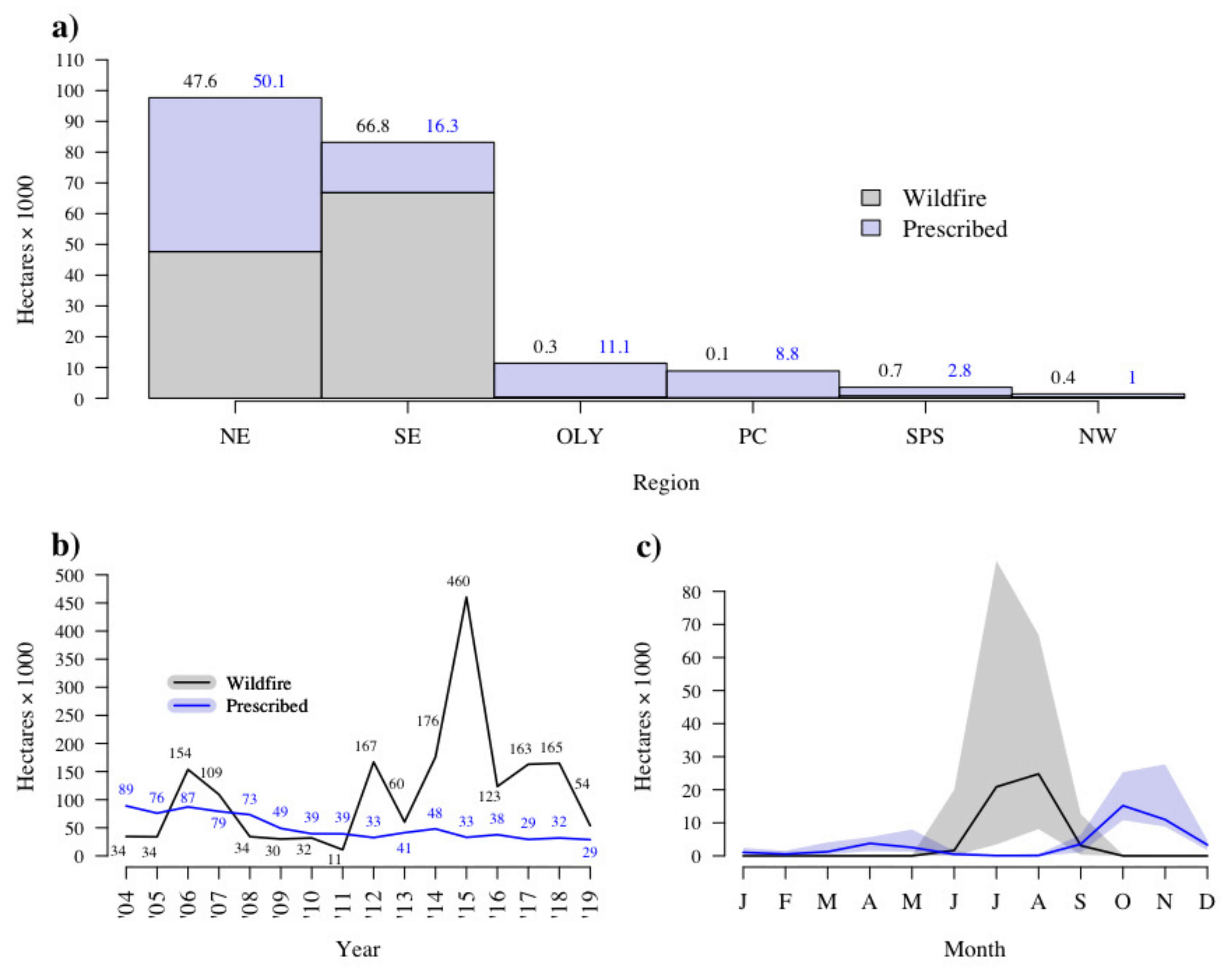

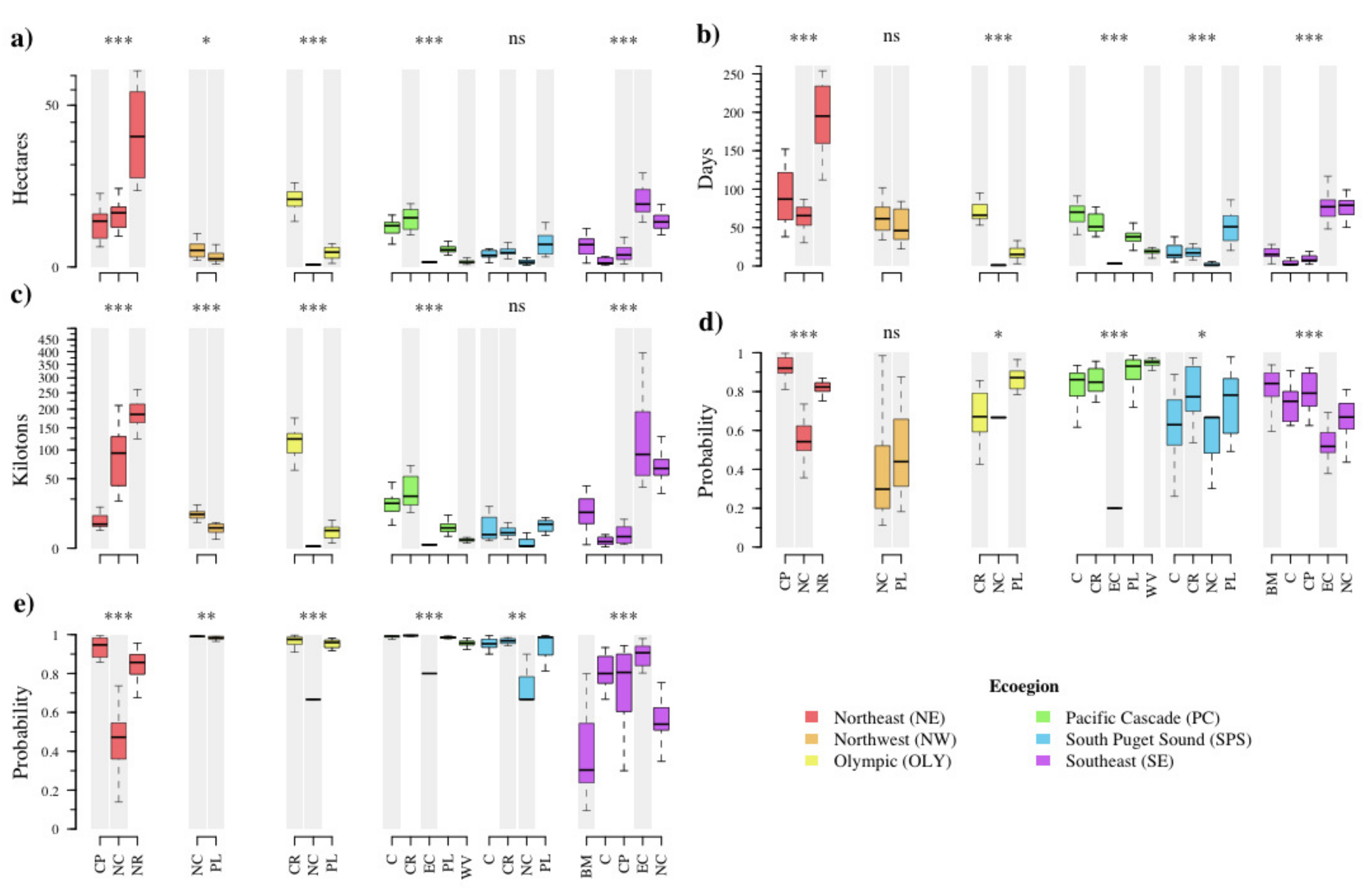

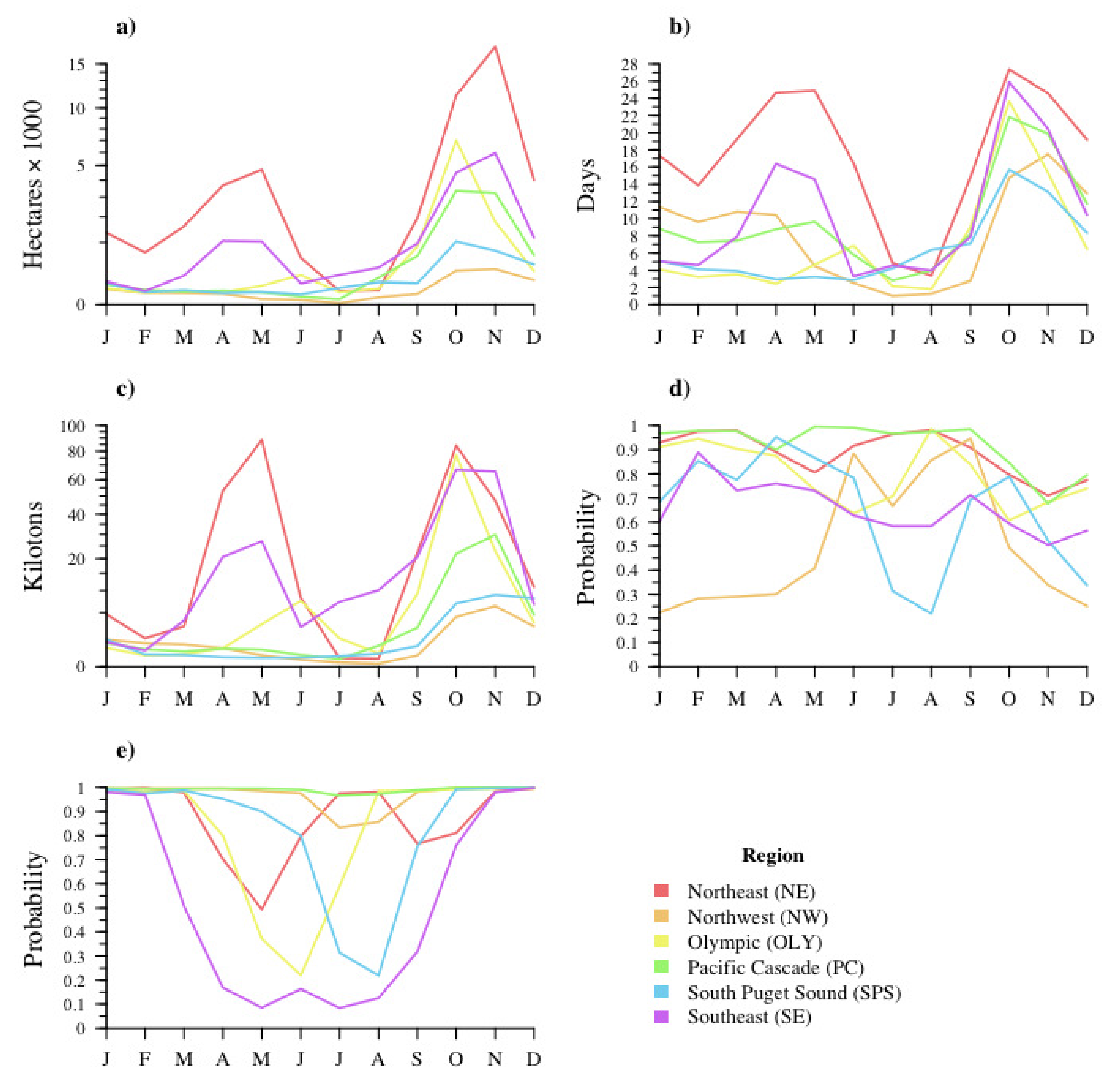
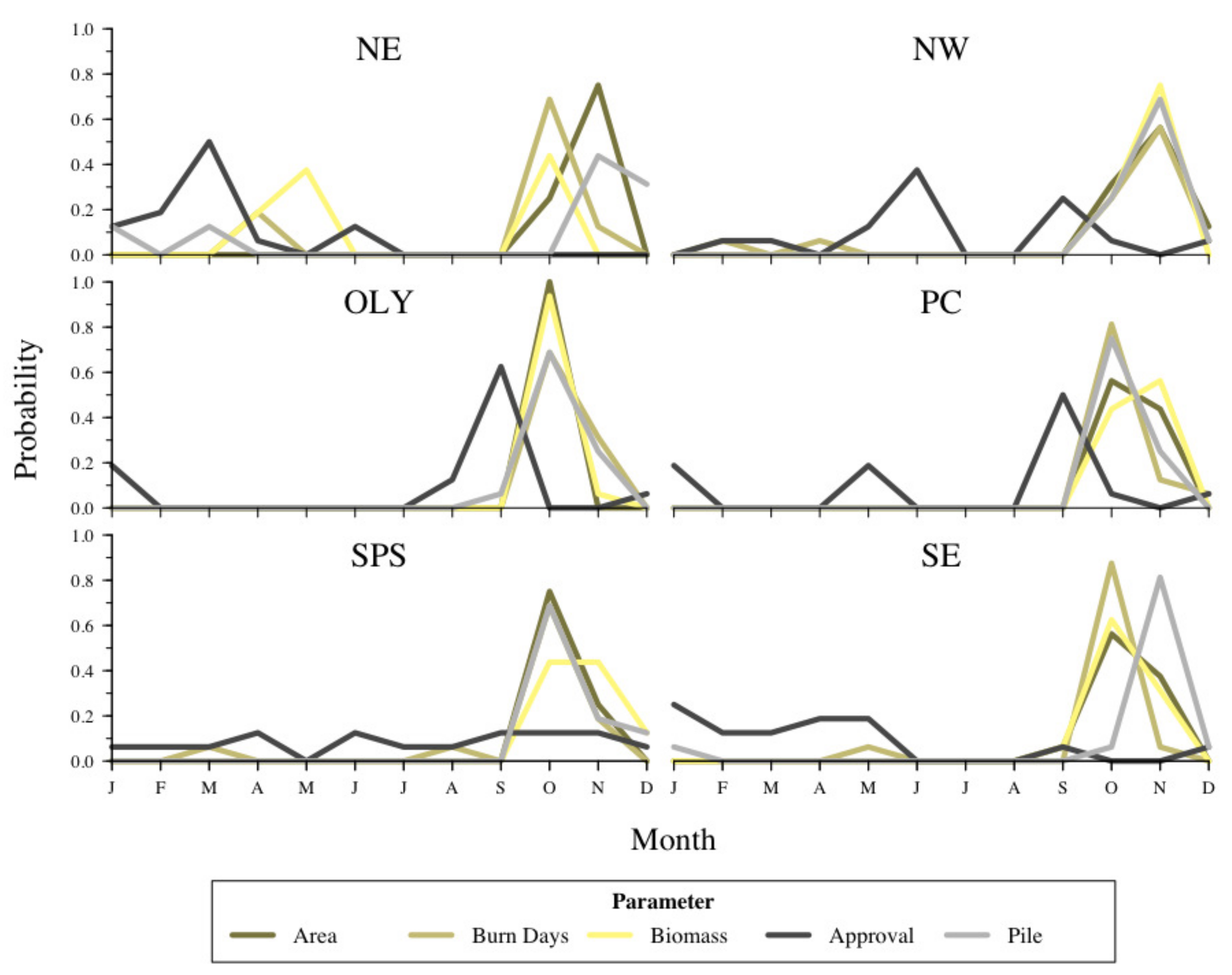
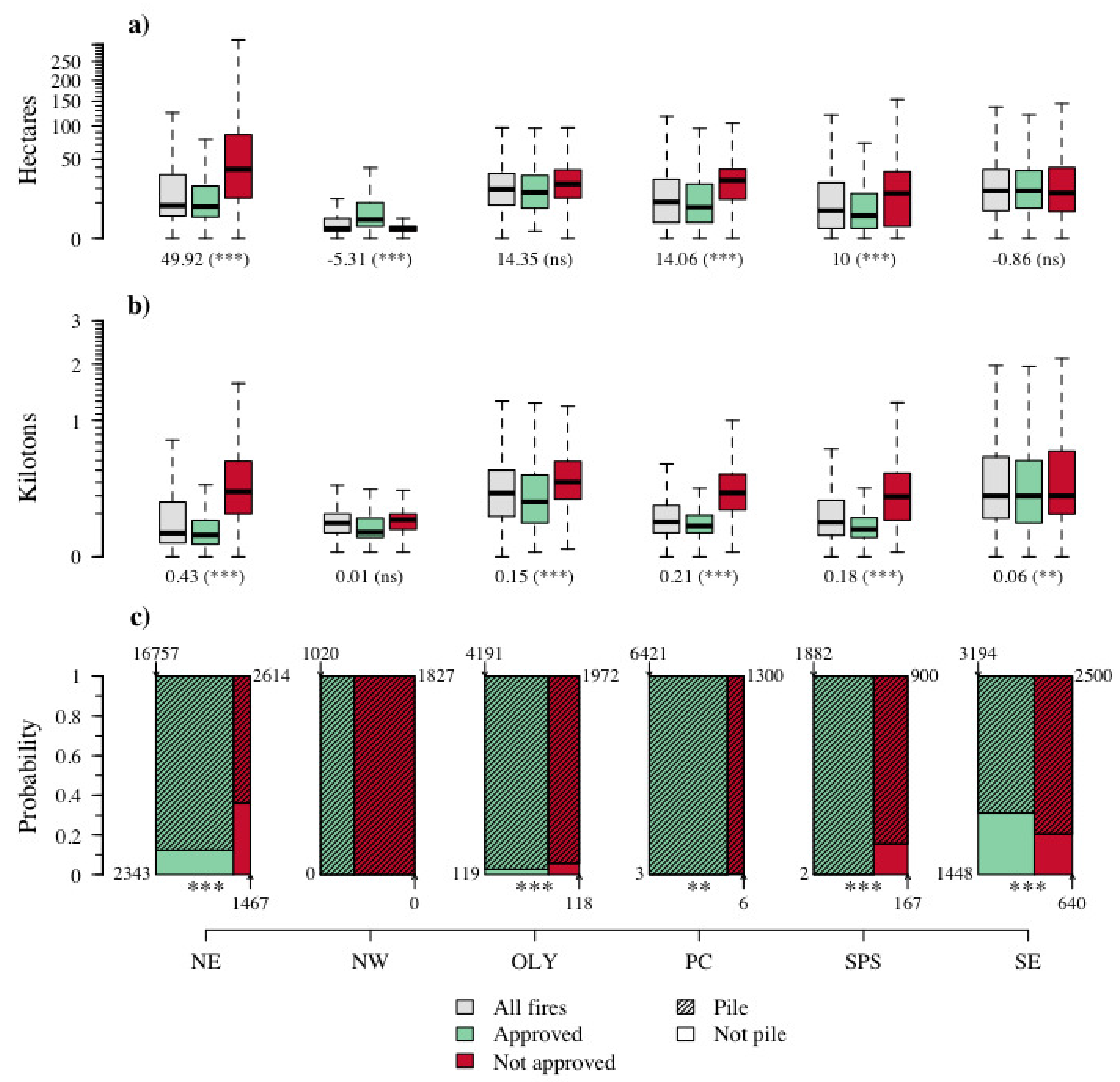
| Region | Total | Approved | Category | |||
|---|---|---|---|---|---|---|
| Yes | No | Broadcast | Natural | Pile | ||
| NE | 23,181 | 19,100 | 4081 | 2578 | 1232 | 19,371 |
| NW | 2847 | 1020 | 1827 | 0 | 0 | 2847 |
| OLY | 6400 | 4310 | 2090 | 237 | 0 | 6163 |
| PC | 7730 | 6424 | 1306 | 9 | 0 | 7721 |
| SPS | 2951 | 1884 | 1067 | 9 | 160 | 2782 |
| SE | 7782 | 4642 | 3140 | 1061 | 1027 | 5694 |
| Region | Total | Ownership | Ecoregion | |||||||||
|---|---|---|---|---|---|---|---|---|---|---|---|---|
| Public | Private | BM | C | CR | CP | EC | NC | NR | PL | WV | ||
| NE | 35,892 (20%) | 15,406 (43%) | 20,485 (57%) | 0 (0%) | 0 (0%) | 0 (0%) | 7682 (21%) | 0 (0%) | 6789 (19%) | 21,420 (60%) | 0 (0%) | 0 (0%) |
| NW | 17,291 (10%) | 10,873 (63%) | 6418 (37%) | 0 (0%) | 0 (0%) | 0 (0%) | 0 (0%) | 0 (0%) | 12,091 (70%) | 0 (0%) | 5089 (30%) | 0 (0%) |
| OLY | 13,530 (8%) | 8132 (60%) | 5398 (40%) | 0 (0%) | 0 (0%) | 10,418 (77%) | 0 (0%) | 0 (0%) | 1544 (11%) | 0 (0%) | 1507 (11%) | 0 (0%) |
| PC | 18,571 (11%) | 7249 (39%) | 11,323 (61%) | 0 (0%) | 9579 (52%) | 5912 (32%) | 0 (0%) | 1 (<1%) | 0 (0%) | 0 (0%) | 1965 (11%) | 1068 (6%) |
| SPS | 15,200 (9%) | 5723 (38%) | 9477 (62%) | 0 (0%) | 4369 (29%) | 991 (7%) | 0 (0%) | 0 (0%) | 1214 (8%) | 0 (0%) | 8381 (56%) | 0 (0%) |
| SE | 74,942 (43%) | 25,269 (34%) | 49,674 (66%) | 2108 (3%) | 1959 (3%) | 0 (0%) | 53,936 (72%) | 8185 (11%) | 8753 (12%) | <1 (<1%) | 0 (0%) | 0 (0%) |
| Region | Area | Burn Days | Biomass | Approvals | Pile |
|---|---|---|---|---|---|
| NE | −5.14 (***) | −7.80 (***) | −21.3 (*) | −0.0032 (ns) | −0.0047 (ns) |
| NW | 0.07 (ns) | 2.42 (ns) | 1.43 (**) | −0.0167 (ns) | 0.0003 (*) |
| OLY | −0.48 (ns) | −2.32 (*) | −5.68 (*) | 0.0132 (ns) | 0.0049 (**) |
| PC | −0.32 (ns) | −2.51 (*) | −2.91 (ns) | 0.008 (ns) | −0.0002 (ns) |
| SPS | −0.29 (ns) | −1.21 (ns) | −4.97 (**) | 0.0122 (ns) | −0.0051 (ns) |
| SE | −1.40 (**) | −2.11 (**) | −20.66 (***) | 0.0021 (ns) | 0.0037 (ns) |
| Region | Area | Burn Days | Biomass | Approvals | Pile | |||||
|---|---|---|---|---|---|---|---|---|---|---|
| Major | Minor | Major | Minor | Major | Minor | Major | Minor | Major | Minor | |
| NE | Nov (17.22) | May (4.71) | Oct (27.38) | May (24.88) | May (88.49) | Oct (84.17) | Aug (0.982) | Mar (0.979) | Feb (0.998) | Dec (0.996) |
| NW | Nov (0.33) | Nov (17.50) | Mar (10.81) | Nov (6.29) | Sep (0.946) | Jun (0.884) | Nov (0.999) | Mar (0.996) | ||
| OLY | Oct (6.99) | Jun (0.23) | Oct (23.62) | Jun (6.85) | Oct (77.10) | Jun (7.42) | Aug (0.985) | Feb (0.945) | Dec (0.995) | Mar (0.986) |
| PC | Oct (3.37) | Apr (0.05) | Oct (21.81) | May (9.62) | Nov (29.92) | Apr (0.56) | May (0.996) | Sep (0.985) | Nov (>0.999) | May (0.996) |
| SPS | Oct (1.03) | Aug (0.13) | Oct (15.69) | May (3.25) | Nov (8.9) | Apr (0.952) | Feb (0.854) | Dec (0.998) | Mar (0.988) | |
| SE | Nov (5.95) | Apr (1.05) | Oct (25.88) | Apr (16.38) | Oct (66.90) | May (26.99) | Feb (0.889) | Apr (0.760) | Dec (0.998) | Jun (0.163) |
Publisher’s Note: MDPI stays neutral with regard to jurisdictional claims in published maps and institutional affiliations. |
© 2021 by the authors. Licensee MDPI, Basel, Switzerland. This article is an open access article distributed under the terms and conditions of the Creative Commons Attribution (CC BY) license (https://creativecommons.org/licenses/by/4.0/).
Share and Cite
Podschwit, H.; Miller, C.; Alvarado, E. Spatiotemporal Prescribed Fire Patterns in Washington State, USA. Fire 2021, 4, 19. https://0-doi-org.brum.beds.ac.uk/10.3390/fire4020019
Podschwit H, Miller C, Alvarado E. Spatiotemporal Prescribed Fire Patterns in Washington State, USA. Fire. 2021; 4(2):19. https://0-doi-org.brum.beds.ac.uk/10.3390/fire4020019
Chicago/Turabian StylePodschwit, Harry, Colton Miller, and Ernesto Alvarado. 2021. "Spatiotemporal Prescribed Fire Patterns in Washington State, USA" Fire 4, no. 2: 19. https://0-doi-org.brum.beds.ac.uk/10.3390/fire4020019







